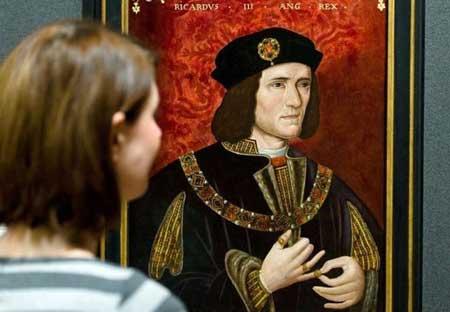當前位置: Language Tips> 雙語新聞
King Richard III's skeleton found under English carpark
分享到
 |
|
A painting of England's King Richard III by an unknown artist is displayed in the National Portrait Gallery in central London on January 25, 2013. |
|
Scientists confirmed Monday that a skeleton found under a carpark in the English city of Leicester was that of King Richard III, in a bizarre end to a 500-year-old historical mystery. DNA from the bones matched that of descendants of the king's sister, while the skeleton had the twisted spine and battle injuries consistent with contemporary accounts, said researchers from the University of Leicester. The remains of the monarch -- depicted by William Shakespeare as a monstrous hunchback and often viewed as one of English history's greatest villains -- will now be solemnly reburied in the local cathedral. The discovery has caused huge excitement among historians, as it provides firm evidence about a monarch whose life has been shrouded in controversy since his death at the Battle of Bosworth in 1485. According to historical accounts, Richard's body was transported naked and bloody on the back of a pack horse to Leicester before being buried in an unmarked grave at Greyfriars, a Franciscan friary in the central English city. The crown passed from the Plantagenet dynasty to the Tudor monarchs who painted Richard as a deformed villain who stopped at nothing in his quest for power, even murdering his two young nephews -- the so-called Princes in the Tower -- to secure the throne. The hunt for his body began in earnest in 2012 when archaeologists working on historical accounts and geographical clues started to dig beneath the municipal carpark on the spot where Greyfriars was, and found the skeleton. On Monday the research team said the skeleton confirmed that the monarch had severe scoliosis, or twisting of the spine. It may have been painful and caused his right shoulder to appear higher than his left, but there was no evidence of the withered arm depicted in Shakespeare's "Richard III". Historians now hope to dispel some of the myths about Richard, publicising evidence to refute claims that he killed the two young princes and focusing on what he achieved in his brief two-year reign, including the establishment of a system of bail and legal aid. Philippa Langley, a member of the Richard III Society who coordinated and helped fund the search, said she hoped a new image would emerge of the king and "the two-dimensional character devised by the Tudors will be no more". "We have searched for Richard and we have found him. Now it's time to honour him," she said. (Read by Brian Salter. Brian Salter is a journalist at the China Daily Website.) |
英國科學家本周一證實,萊斯特市的一個停車場地下挖出的遺骸為15世紀英格蘭國王理查三世,這也解開了長達五百年的謎團。 萊斯特大學研究人員表示,這副骸骨的DNA同理查三世一名姐妹的后代吻合,而且骸骨的脊柱彎曲,有戰爭留下的創傷,這都與歷史記載吻合。 理查三世的遺骨將在當地教堂被正式重新埋葬。他一直被視為英國歷史上最殘酷的暴君之一,威廉-莎士比亞將其刻畫為“駝背的暴君”。 這一發現引起了歷史學家的極大關注,因為這為了解理查三世提供了更加確鑿的證據。理查三世于1485年死于博斯沃思戰役,之后有關他的一生一直充滿爭議。 根據歷史記載,理查三世戰敗后,其裸露的尸體曾被放在一匹馱馬上運往萊斯特,后埋在萊斯特一家方濟會修道院的墓地,但沒有任何標記。萊斯特位于英國中部。 理查三世是金雀花王朝的最后一位國君,都鐸王朝的繼任者將其塑造成了不惜一切代價追求權力的無惡不作的暴君,還稱他謀殺了他的兩個侄子-也就是“塔中王子”-來保住王位。 2012年,科學家開始認真尋找他的遺體。考古學家根據史書記載和地理線索,在一個市政停車場開始挖掘,并最終發現了遺骨。這里就是史書記載中埋葬查理三世的教堂的地點。 本周一,研究小組表示,根據遺骨可以看出,理查三世患有嚴重的脊柱側彎,或者說脊柱彎曲。這會讓他十分痛苦,還會導致右肩比左肩高,但莎士比亞的《理查三世》中描述的枯萎的手臂卻無從證實。 歷史學家希望解開有關理查三世的謎團,公開證據以反駁他殺害了兩個年輕侄子的說法,重點關注他在位兩年期間的成就,包括建立了保釋制度和法律援助制度。 “理查三世研究小組”的成員菲利帕?朗麗說,她希望能重塑理查三世的形象,都鐸王朝的繼任者塑造出來的片面形象將不復存在。她負責協調研究工作以及籌款。 她說:“我們一直在尋找他的遺骨,終于找到了。現在是為他恢復名譽的時候了。” 相關閱讀 (中國日報網英語點津 Julie 編輯:陳丹妮) |
|
Vocabulary: hunchback: 駝背 Franciscan: 方濟會的 stop at nothing: 不惜一切代價,毫無顧忌 scoliosis: 脊柱側彎 |
上一篇 : 2013全球最貴城市 澳城市成“新貴”
下一篇 : 調查:網上辦公八成時間被浪費
分享到
關注和訂閱


電話:8610-84883645
傳真:8610-84883500
Email: languagetips@chinadaily.com.cn